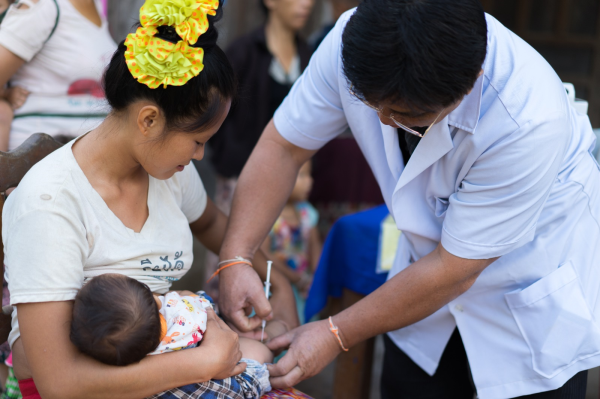KPL
(KPL) The Lao PDR’s public health aspirations have seen remarkable progress in recent decades, especially in the area of immunization. The nation boasts vaccination rates for the human papillomavirus (HPV) and COVID-19 which are above regional averages - the former at 95 per cent compared to the region’s average of 22.5 per cent. But the threat of this progress backsliding looms over the country as deep-seated gender disparities threaten to leave vulnerable groups behind, finds a new groundbreaking UNICEF study.
How We Can Transform Immunization in the Lao PDR by Promoting Greater Gender Equality.

(KPL) The Lao PDR’s public health aspirations have seen remarkable progress in recent decades, especially in the area of immunization. The nation boasts vaccination rates for the human papillomavirus (HPV) and COVID-19 which are above regional averages - the former at 95 per cent compared to the region’s average of 22.5 per cent. But the threat of this progress backsliding looms over the country as deep-seated gender disparities threaten to leave vulnerable groups behind, finds a new groundbreaking UNICEF study.
The ‘Gender analysis for routine immunization, HPV and COVID-19 vaccination programmes in the Lao PDR’ study shows how social and cultural norms, economic pressures and systemic gaps in accessing health information and services create invisible barriers to vaccines, particularly for women, girls and ethnic communities.
Women are often designated as primary caregivers. However, women, especially young women, adolescents, or those from ethnic communities, tend to have lower decision-making power, knowledge, resources, time and mobility, which impacts their ability to vaccinate their children and themselves. These barriers are common across different types of vaccinations, including routine childhood immunization, HPV, and COVID-19 vaccines. Ethnic communities, especially those in remote areas, face additional linguistic and mobility challenges to accessing health services.
“Findings from this new study are vital in identifying a roadmap towards ensuring no one is left behind when it comes to vaccination,” said Dr. Phonepaseuth Xayyamongkhoun, Director of Department of Hygiene and Health Promotion, Ministry of Health. “Breaking the barriers identified in this study is an important priority for the Lao PDR’s public health and in achieving equitable immunization coverage for all.”
The Silent Struggle
In the bustling markets of Vientiane and the remote villages of Phongsaly, mothers like Khamsy, 28, bear the dual burden of work and childcare. "I missed my daughter’s measles vaccine because the health centre was too far and my husband said we couldn’t afford the trip," she shares.
Khamsy’s story is common among rural communities and echo the new study’s stark statistic: 60 per cent of interviewed female caregivers reported a lack confidence in vaccine decisions, often deferring to husbands or elders. While in some cases mothers do lead vaccination decisions, particularly for routine immunization and HPV vaccines for girls, men in the family frequently hold the final authority, including the power to veto decisions. They also tend to have greater influence over vaccination choices for boys than mothers do. Regardless of who holds influence, the study highlights that adolescents generally have limited agency in making vaccination decisions, which are instead made primarily by parents and are often shaped by misinformation.
Some ethnic communities have cultural norms that may limit access to primary health care as well. For instance, 50 per cent of ethnic girls marry young by the age of 18, which cuts short both their education prospects and their access to HPV vaccination. On the other hand, certain rural ethnic communities with different cultural contexts may face other logistical hurdles. These communities tend to be far away from health centres and parents living there often work in rice fields during vaccination drives, leaving gaps in vaccination coverage. This is evident in the vaccination rate between urban and rural areas - for example, the province of Phongsaly has only 62 per cent routine immunization coverage compared to 85 per cent in urban areas.
Moreover, systemic gaps in health systems present additional barriers, including the lack of gender targets in immunization policies, inadequate pay for female health workers who make up 71 per cent of the workforce and the absence of sex-disaggregated data.
The Way Forward
“Women, despite being the primary care givers, often lack agency when it comes to decisions around immunization,” said Mr. Bilal Durrani, UNICEF Country Representative in the Lao PDR. “The path forward is clear. By empowering women, bridging information gaps and addressing systemic bottlenecks, we can ensure equitable access to vaccines for all — no matter their ethnicity or where they live.”
The key lies in empowering mothers like Khamsy, which requires the creation of enabling environments, including making health services and information accessible, and addressing social and gender norms that limit women's health decision-making for themselves and their families. Furthermore, targeted engagement of men and fathers to increase participation in caregiving roles and shifting household decision-making, and addressing communication barriers by ensuring vaccine information is available in local ethnic languages should be prioritized too. Partnerships with village chiefs and religious leaders, who influence 80 per cent of vaccine-hesitant families, are also crucial. This should be coupled with systemic fixes, such as funding mobile clinics to reach remote areas and implementing safety policies to protect female health workers.
Progress is possible. By using the momentum built through current progress in national vaccination efforts, these barriers should be tackled head-on so the Lao PDR can ensure vaccines reach every everyone.
#MediaforoneHealth#
KPL